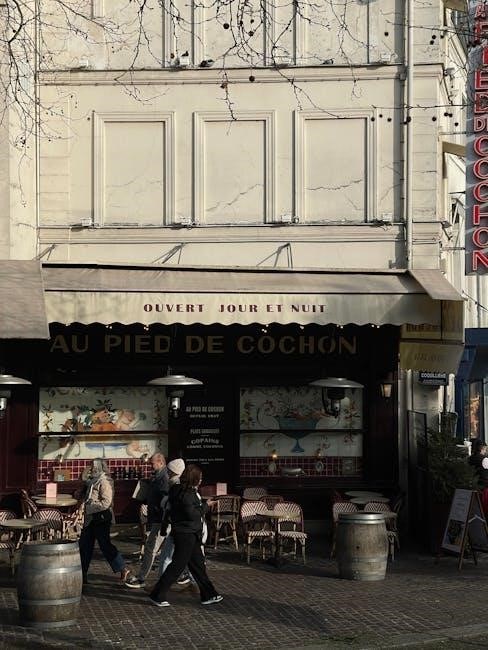The Allied bombings in France during WWII caused over 57,000 civilian casualties, with 20% of all European bombs targeting France, crucial for liberation but devastating for civilians.
Overview of Allied Bombings in France During WWII
The Allied bombings in France during WWII were extensive, with over 516,635 tonnes of bombs dropped between 1939 and 1945. This included 80,000 tonnes in 1944 alone, targeting key industrial and military sites. Cities like Dunkirk, Boulogne-Billancourt, and Le Creusot suffered heavily, with significant civilian casualties. The bombings were part of a broader strategy to weaken German forces and prepare for the D-Day invasion. However, the impact on French civilians was devastating, with over 57,000 deaths and 74,000 injuries. The campaigns also caused widespread destruction of infrastructure, leaving many communities in ruins. These events remain a critical yet tragic chapter in France’s wartime history.

Key Objectives and Historical Context

The Allied bombings in France during WWII aimed to weaken German forces, disrupt supply lines, and prepare for the D-Day invasion. Strategically, these campaigns targeted industrial sites, rail networks, and military installations to undermine Nazi control. Historically, the bombings were part of a broader effort to liberate Western Europe, with France being a critical battleground. The Allies sought to destabilize Germany’s grip on occupied territories while minimizing delays in advancing ground forces. However, the bombings also posed moral dilemmas, as civilian casualties and infrastructure destruction weighed heavily against military gains. This context underscores the complexity of balancing strategic objectives with humanitarian concerns during wartime.

Causes and Objectives of the Allied Bombings
The Allied bombings aimed to destabilize German forces, disrupt supply lines, and weaken industrial capacity in occupied France, crucial for advancing the liberation of Western Europe.
Strategic Necessity: Weakening German Forces in France
The Allied bombings in France were driven by the urgent need to weaken German military strength and disrupt their operational capabilities. Key industrial and logistical targets, such as factories, railroads, and ports, were prioritized to cripple the enemy’s supply lines and communication networks. Cities like Dunkirk and Boulogne-Billancourt, with their strategic importance to German forces, were heavily targeted. These raids were part of a broader strategy to prepare for the D-Day invasion and the eventual liberation of Western Europe. By destroying critical infrastructure, the Allies aimed to reduce German resistance and create favorable conditions for ground forces advancing across France.
Supporting the D-Day Invasion and Liberation of Western Europe
The Allied bombings in France played a pivotal role in supporting the D-Day invasion and the liberation of Western Europe. By targeting German fortifications, supply lines, and communication networks, the bombings weakened enemy defenses, facilitating the successful landing of Allied forces in Normandy on June 6, 1944. Key infrastructure, such as railroads and bridges, was destroyed to disrupt German reinforcements and create chaos. These aerial campaigns were meticulously coordinated with ground operations, ensuring that the liberation efforts gained momentum. The sustained bombardments also supported the advancement of Allied troops, enabling them to secure territories and ultimately push German forces out of France. This strategic air support was indispensable to the Allied victory.

Impact on French Civilians
The Allied bombings caused over 57,000 civilian casualties in France, destroying homes, infrastructure, and causing a severe humanitarian crisis, deeply affecting the population’s daily life and well-being.
Civilian Casualties and Humanitarian Crisis
The Allied bombings in France during WWII resulted in over 57,000 civilian deaths and 74,000 injuries, with 300,000 homes destroyed. Cities like Dunkirk, Boulogne-Billancourt, and Le Pont-Saint-Esprit suffered heavily, experiencing hundreds of fatalities in single raids. The destruction of infrastructure disrupted essential services, worsening the humanitarian crisis. Civilian life was severely impacted, with many left without shelter or access to basic necessities. The bombings caused widespread trauma and displacement, leaving communities devastated. These events underscore the tragic cost of the war on innocent populations, highlighting the immense human toll beyond military objectives. The crisis strained resources and shaped the post-war reconstruction efforts in France.
Destruction of Infrastructure and Economic Toll
The Allied bombings caused significant destruction of France’s infrastructure, with 516,635 tonnes of bombs dropped between 1939 and 1945. Key industrial sites, railways, and ports were targeted, crippling the economy. Entire neighborhoods in cities like Le Havre and Marseille were reduced to rubble, leaving thousands without shelter. The destruction disrupted essential services, exacerbating the humanitarian crisis. Economic recovery became a major challenge post-war, requiring substantial reconstruction efforts. The bombings not only devastated physical structures but also had a lasting impact on France’s economic stability, highlighting the costly consequences of the war beyond immediate military objectives.

Key Allied Bombing Campaigns in France
The Allied bombing campaigns in France targeted strategic locations, including Dunkirk (May 27, 1940), Boulogne-Billancourt (March 23, 1942), and Le Creusot, causing significant destruction and civilian casualties.
The Bombing of Dunkirk (May 27, 1940)

The Allied bombing of Dunkirk on May 27, 1940, was a pivotal event during WWII, targeting German forces occupying the city. Over 1,000 civilians and soldiers were killed, with the port area being heavily damaged. This raid aimed to disrupt German supply lines and communication, aiding the evacuation of Allied troops during the Battle of Dunkirk. The bombing marked one of the earliest major Allied airstrikes in France, setting the stage for future campaigns. While strategically significant, it caused immense civilian suffering, highlighting the tragic consequences of warfare. The destruction of Dunkirk’s infrastructure also hampered post-war reconstruction efforts in the region.
The Bombing of Boulogne-Billancourt (March 23, 1942)
The bombing of Boulogne-Billancourt on March 23, 1942, was one of the first major Allied raids on France, targeting industrial sites crucial for German war production. The Renault factory, producing military vehicles, was the primary objective. Over 600 civilians lost their lives, and extensive damage was caused to residential areas. This mission marked the beginning of systematic Allied bombing campaigns in occupied France, aiming to weaken German resources. It also served as a strategic precursor to larger operations, showcasing the Allies’ growing airpower capabilities. The raid, while successful in disrupting production, had devastating consequences for the local population, underscoring the human cost of such military actions during WWII.
Military and Strategic Outcomes
The Allied bombings significantly disrupted German supply lines and communication, weakening their grip on France and paving the way for the liberation of Western Europe.
Disruption of German Supply Lines and Communication
The Allied bombings in France during WWII strategically targeted German supply lines, railways, and communication networks, crippling their ability to maintain control. Key infrastructure, such as bridges and railways, was destroyed, severely disrupting troop movements and logistics. This disruption weakened the German army’s effectiveness, making it difficult for them to respond to Allied advances. The bombings also severed critical communication lines, isolating German units and hindering coordination. These actions were crucial in undermining the enemy’s operational capacity, ultimately supporting the success of the D-Day invasion and the broader liberation of Western Europe.
Preparation for the Liberation of France
The Allied bombings in France played a pivotal role in preparing for the liberation by targeting key German military installations and infrastructure. Strategic sites such as ports, railways, and airfields were heavily bombed to disrupt enemy logistics and weaken their grip on occupied territories. These campaigns ensured that German forces were unable to reinforce their positions effectively, creating an environment conducive to the Allied ground advances. The bombings also supported the D-Day invasion by crippling German mobility and communication networks, allowing Allied troops to gain a foothold in Normandy and begin the push across Western Europe. This strategic effort was essential for the eventual liberation of France from Nazi occupation.

Long-Term Consequences
The Allied bombings left deep scars in France, with extensive infrastructure damage and economic struggles. Reconstruction efforts were vital to revive the nation’s war-torn regions and economy.

Reconstruction Efforts and Economic Recovery
Post-WWII, France faced the daunting task of rebuilding cities and infrastructure devastated by Allied bombings. Entire neighborhoods, factories, and transportation networks lay in ruins, requiring massive investment and labor. The reconstruction process was gradual, with communities rallying together to restore essential services and housing. Economic recovery was further complicated by the loss of industrial capacity and workforce disruptions. Despite these challenges, the reconstruction efforts laid the foundation for France’s post-war economic revival, fostering resilience and unity among its people. The scars of the bombings remained, but the collective effort to rebuild symbolized hope and determination for a brighter future.
Historical Memory and Commemoration
The Allied bombings in France during WWII are remembered through various commemorations and memorials, honoring the lives lost and the liberation they facilitated. Anniversaries like the 80th anniversary of the end of WWII and D-Day are marked with ceremonies and reflections. Many cities, such as Dunkirk and Boulogne-Billancourt, have memorials dedicated to the civilians who perished. These events and sites serve as reminders of the sacrifices made during the war and the shared history between France and the Allied nations. Commemorations also highlight the resilience of communities that rebuilt their lives and cities after the devastation.
The Allied bombings in France during WWII were crucial for liberation but devastating for civilians, causing over 57,000 deaths and widespread destruction, leaving a lasting legacy of resilience and remembrance.
Legacy of the Allied Bombings in France
The Allied bombings in France during WWII left a profound and complex legacy, marked by both liberation and loss. While they played a crucial role in weakening German forces and paving the way for the D-Day invasion, the civilian toll was devastating. Over 57,000 French civilians lost their lives, and widespread destruction impacted communities for decades. Today, these events are commemorated through museums, memorials, and annual ceremonies, ensuring the sacrifices of both soldiers and civilians are remembered. The bombings also spurred significant reconstruction efforts, reshaping France’s post-war identity and economy. This duality of triumph and tragedy remains central to France’s historical memory of the war.
Balancing Strategic Success with Civilian Cost
The Allied bombings in France achieved significant strategic goals, such as disrupting German supply lines and supporting the D-Day invasion, but at a heavy civilian cost. Over 57,000 French civilians lost their lives, and countless others were injured or left homeless. The destruction of infrastructure, including homes, schools, and hospitals, had a lasting impact on communities. While the bombings were crucial for liberating Western Europe, the humanitarian toll remains a somber reminder of the war’s brutality. France continues to honor both the sacrifice of its people and the Allied efforts that ultimately led to freedom, reflecting on the delicate balance between military necessity and human suffering.